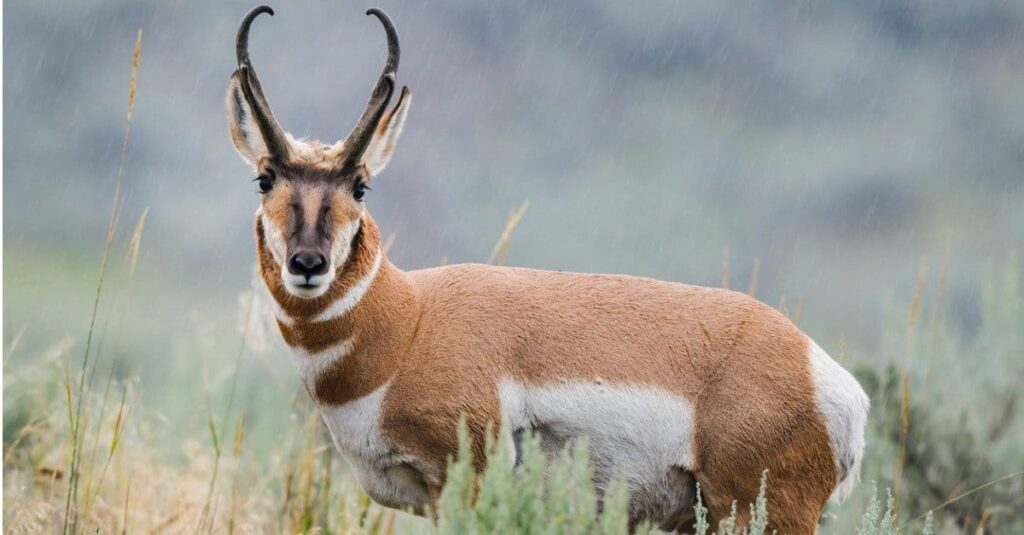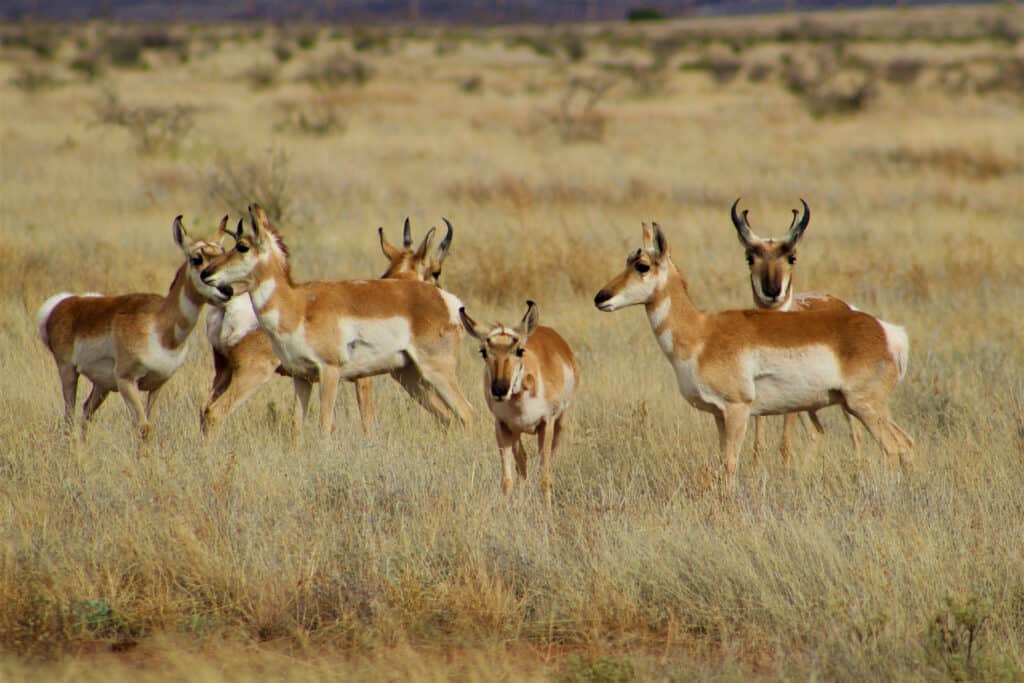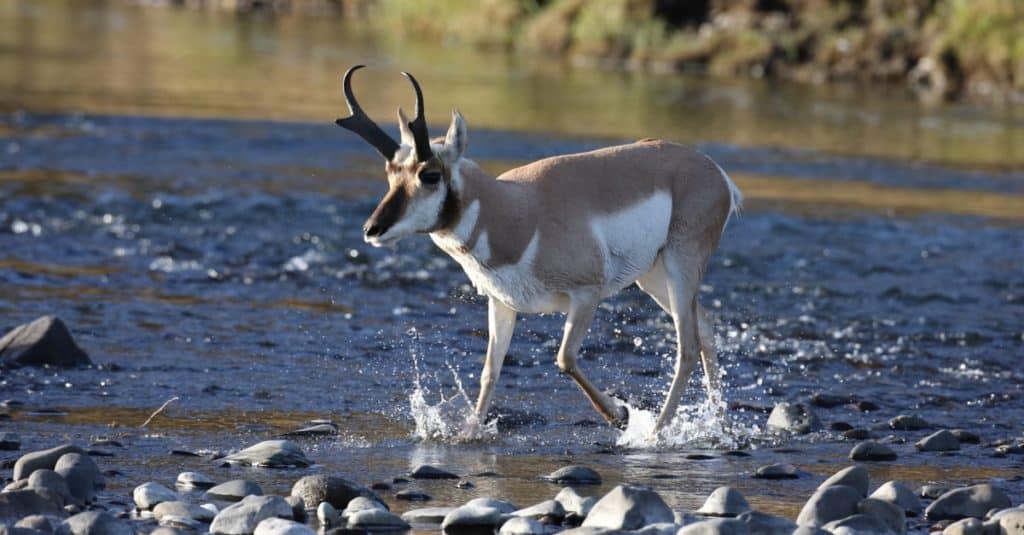Montana is known for its stunning landscapes, rugged terrain, and abundant wildlife. For many hunters, the state’s pronghorn population is a key draw. These nimble creatures, also known as antelope, can run at incredible speeds of up to 60 mph. This makes them a challenging but rewarding quarry. This is important to keep in mind as you learn of the largest pronghorn ever caught in Montana.
Over the years, Montana has produced many notable pronghorn catches.
Today, we discover the largest pronghorn ever caught in Montana and worldwide. We also learn a few more attributes about this remarkable animal.
The Largest Pronghorn Ever Caught in Montana
The largest pronghorn ever caught in Montana scored 91 4/8 points. Cabela’s, Inc. currently owns the trophy. Donald W. Yates caught the animal in 1977, breaking the four-year record posted by Jim Ollom in 1973. Ollom’s catch, currently owned by B&C National Collection, scored 89 6/8 points.

©BGSmith/Shutterstock.com
The Largest Pronghorn Ever Caught Worldwide
The largest pronghorn ever caught worldwide measured 96 4/8 inches. Mike Gallo caught the pronghorn in Socorro County, New Mexico.
Gallo’s catch beat the previous record, held by Dylan Woods since 2000, by 1.5 inches.
Background on Pronghorn
Pronghorn are fascinating animals native to North America. They’re the only surviving species of the family Antilocapridae. They’re not true antelopes.
Physical Appearance and Adaptations
Pronghorn are unique animals known for their distinctive physical appearance and adaptations. They’re slender, long-legged animals with a reddish-brown coat with white patches on the throat, belly, rump, and behind the eyes.
They have a distinctive pair of horns shed annually. The horns comprise a bony core covered in a keratinous sheath. These horns are different from those of true antelopes as they have a prong, hence their name, that curves forward from the base of each horn.
Pronghorn are well adapted to life on the Great Plains and Intermountain West. They’re fast runners and can reach speeds of up to 60 mph. This makes them among the world’s fastest land animals.
They have excellent vision, with eyes positioned high on their head to give them a wide field of view. They can also see in color and have excellent depth perception.
Historical Range and Human Impact
Historically, pronghorns had a wide range extending from southern Canada down to northern Mexico. They’re an ancient species that has been around for over a million years.
But human activity has impacted their range, particularly in the United States. As European settlers moved westward, pronghorn populations were decimated by:
- Habitat loss
- Hunting
- Competition with domestic livestock
By the early 20th century, pronghorn populations had declined to dangerously low levels. As a result, conservation efforts were needed to prevent their extinction.
Importance to Economy
Today, pronghorn populations have rebounded. You can find the animals in various habitats across the western United States, including Montana.
Pronghorn are also important for Montana’s economy. They’re a popular game animal for hunters. Hunting permits provide revenue for the state and local communities, and many outfitters offer pronghorn hunting trips to visitors.

©Charles Lemar Brown/Shutterstock.com
Pronghorn in Montana
Montana is an important state for the pronghorn. It’s home to a significant population of these unique animals.
Habitat
Pronghorn are found primarily in the eastern part of Montana, where they live in grasslands and shrublands. These habitats are important as they provide the open space they require to run and graze.
Pronghorn are well-adapted to life in these habitats, as they can tolerate a wide range of temperatures and have a digestive system that allows them to digest tough, fibrous plants.
Population and Distribution
Pronghorn populations in Montana have fluctuated over time, with periods of decline and recovery.
In the early 20th century, pronghorn populations in Montana were severely depleted due to overhunting and habitat loss.
But conservation efforts helped to restore populations, and today there are about 40,000 pronghorns in Montana.
You’ll find pronghorns throughout Montana, but their distribution isn’t uniform. They tend to be concentrated in the eastern part of the state, particularly in the northeastern and southeastern corners. This is where the grassland and shrubland habitats that they require are most common.
Role in Ecosystem
Pronghorns play an important role in Montana’s ecosystem. As herbivores, they graze on various plants, including grasses and forbs.
Their grazing helps to maintain the grassland and shrubland habitats that they require. It also plays a vital role in seed dispersal. By consuming plants and spreading their seeds through their feces, pronghorns help to ensure plant communities’ growth and regeneration.
Pronghorn are also an important prey species for predators in Montana, including coyotes and wolves.
They are fast runners, making them difficult to catch but not invincible. Predation by coyotes and wolves is a natural part of the ecosystem. It helps maintain a balance between prey and predator populations.
Importance for Conservation
Pronghorn are an important species for conservation in Montana. They’re part of the state’s natural heritage and play an important role in the ecosystem.
To protect pronghorn populations, managing their habitat and controlling hunting sustainably is important.
Montana has several conservation programs in place to protect pronghorn, including efforts to:
- Restore grassland and shrubland habitats
- Limit the number of hunting permits issued each year

©Leupold, James C – Public Domain by U.S. Fish and Wildlife Service
Threats to Pronghorn
Despite their resilience and adaptability, pronghorn populations in Montana and across North America face various threats. Here are some of the most significant threats to pronghorn and their habitats.
Loss and Fragmentation of Habitats
Habitat loss and fragmentation are major threats to pronghorn populations.
In many areas, grassland and shrubland habitats are being converted to cropland, urban areas, or other land uses. This can fragment pronghorn populations, making it difficult for them to find suitable habitats and maintain genetic diversity.
In addition, habitat loss can lead to increased competition for resources and increase the risk of predation.
Road Mortality
Pronghorn are susceptible to collisions with vehicles, which can result in injury or death.
Road mortality can significantly threaten pronghorn populations in areas where roads and highways intersect with pronghorn habitats. This is particularly true in areas where pronghorn migration routes cross roads or highways.
Predation
Predation by coyotes and wolves is a natural part of the ecosystem. But in some areas, predation can significantly threaten pronghorn populations.
Coyotes and wolves are efficient predators. Therefore, they can majorly impact pronghorn populations if their numbers are too high.
In addition, predation can be more of a threat in fragmented habitats where pronghorns have fewer places to hide and less protection from predators.
Other pronghorn predators include mountain lions and golden eagles.
Although not a natural predator, humans have significantly impacted pronghorn populations through hunting, habitat destruction, and road construction.
Climate Change
Climate change is an emerging threat to pronghorn populations.
Changes in temperature and precipitation patterns can impact the quality and availability of pronghorn habitats. It can also alter the timing of plant growth and migration.
In addition, changes in weather patterns can affect the availability of water, which is essential for pronghorn survival.
Overhunting
Overhunting was one of the primary causes of the decline in pronghorn populations in the early 20th century. However, it remains a threat to pronghorn in some areas.
Overhunting can reduce populations to unsustainable levels. It can also disrupt social structures and genetic diversity.
Hunting regulations and management plans are in place to help ensure that hunting is done sustainably. However, illegal poaching remains a problem in some areas.
Diseases
Diseases can also be a threat to pronghorn populations.
In particular, pronghorns are susceptible to diseases carried by domestic livestock, such as brucellosis and bovine tuberculosis. These diseases can impact the health of pronghorn populations and can reduce reproductive success.

©Frank Fichtmueller/Shutterstock.com
Pronghorn Viewing in Montana
For wildlife enthusiasts and nature lovers, Montana is a prime destination for pronghorn viewing. With its vast expanses of grassland and shrubland habitats, the state provides ample opportunities to observe these fascinating animals in their natural environment.
Best Places to See Pronghorn in Montana
One of the best places to see pronghorns in Montana is the National Bison Range. Located in the Mission Valley, this wildlife refuge allows visitors to view pronghorns. You’ll also get to view bison, elk, deer, and other wildlife.
The refuge features a 19-mile scenic drive that provides breathtaking views of the surrounding mountains and prairie landscapes.
Another great location for pronghorn viewing is the Charles M. Russell National Wildlife Refuge. This vast wilderness area encompasses over a million acres of grassland, badlands, and river bottom habitats. It provides a diverse range of landscapes for visitors to explore.
The refuge is home to several pronghorn populations, and visitors can view them from the comfort of their vehicles or on foot.
Best Times to See Pronghorn in Montana
The best times to see pronghorns in Montana are during their migration periods. These typically occur in the spring and fall.
During these times, pronghorns move from their summer ranges to winter ones in search of food and shelter. This can result in large groups of pronghorn moving across the landscape, providing excellent viewing opportunities.
Viewing Tips
When viewing pronghorns in Montana, keep a safe distance from the animals and observe them from a respectful distance. It’s also important to respect private property and obtain permission before entering fenced or posted areas.
Additionally, bring binoculars or a spotting scope for optimal viewing. Avoid making sudden movements or loud noises that could startle the animals.
Conservation Efforts and Responsible Viewing
As visitors to Montana, be mindful of our impact on pronghorn populations and their habitats. By following Leave No Trace principles and practicing responsible wildlife viewing, we can help ensure that pronghorn populations remain healthy and sustainable for generations.
Additionally, by supporting conservation efforts and organizations that work to protect pronghorn and their habitats, we can help preserve these fascinating animals and the landscapes they call home.

©matthieu Gallet/Shutterstock.com
Key Takeaways
The largest pronghorn ever caught in Montana was in 1977 and scored 91 4/8 points. Pronghorn are a fascinating species that have adapted to survive in some of the most challenging environments in North America. In Montana, these animals are crucial to the state’s ecosystems. In addition, they’re an important cultural and historical symbol for many Indigenous communities.
Despite their importance, pronghorn populations face various threats, including habitat loss, fragmentation, and disease. Therefore, we must take action to protect pronghorns and their habitats through conservation efforts, responsible land use practices, and sustainable hunting regulations.
At the same time, we can also appreciate pronghorns for the unique and fascinating animals they are and enjoy the opportunity to observe them in their natural environment. By practicing responsible wildlife viewing and supporting conservation efforts, we can help ensure that pronghorns continue to thrive in Montana and beyond.
Whether you are a resident of Montana or just passing through, taking the time to appreciate these iconic animals can be a truly unforgettable experience. From their impressive speed and agility to their unique adaptations for survival, pronghorns are a true testament to the resilience and adaptability of the natural world.
The post Discover The Largest Pronghorn Ever Caught in Montana appeared first on AZ Animals.
from Animal News, Facts, Rankings, and More! - AZ Animals https://ift.tt/kDCHYrF